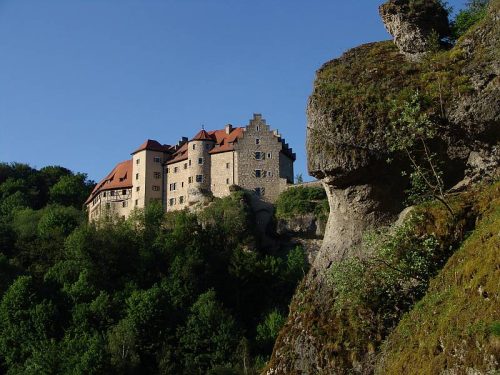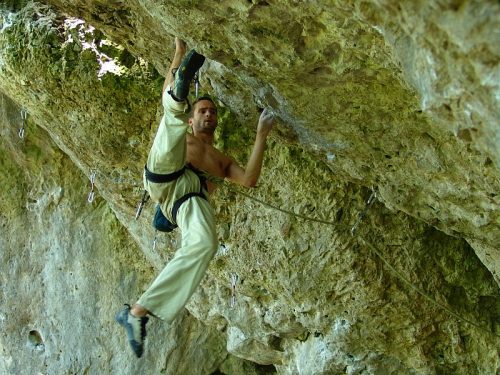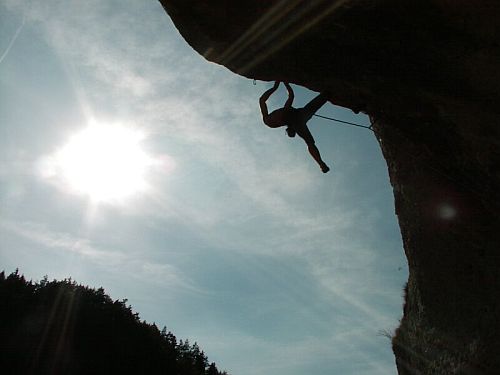Frankenjura Fridays |

There is no better tram ride in Prague than that which carries me to the bus station on Friday afternoons. Hopefully the sun is shining and there is a cool breeze. If not all is not lost: the weather a couple of hundred kilometers to the west can be completely different. I relax from the week’s work, and look forward to a weekend spent with good friends in that climber’s playground which is the Frankenjura.
It may be best to state first what this article isn’t; namely, this is not a comprehensive guide to the Frankenjura. For that matter none exists, not even the latest guides in print. There are more than 7,000 routes tucked away in the valleys and forests of Northern Bavaria, with more added every year.

The gorgeous valley and stunning castle of Rabestein
foto by© JirkaS
Forget what you have heard about the area: those rumors of one finger pockets on steep terrain, fiercely bouldery routes that will mangle all but fingers made of Kevlar. While the most famous routes may be just that, with over seven thousand routes this area is teaming with diversity.

Powerfull climbing, cleanrock- Waischenfelder turm
foto by© JirkaS
You may be wondering what an article about German climbing is doing on a Czech website, which is a natural question. This brings me to my first destination for the weekend: Plzen. Plzen is home to a group of climbers who are as devoted to and knowledgeable about ‘jura limestone as any in Germany. Indeed, many here in the Czech know ‘jura climbing better than their German neighbors; remember that Plzen is closer to the ‘jura than Munich. Besides hosting a lively and active climbing community, Plzen is a comfortable town, replete with pubs offering the finest brew Central Europe has to offer.

Jirka climbing the beautiful Stehversuche, 7+
foto by© JirkaS
After spending Friday evening discussing climbing plans over a pint in one of the climber’s pubs, we head off on Saturday morning. My hosts and climbing partners, Jirka and Jana, travel to the ‘jura almost every weekend of the summer. The travel time is less than two hours from Plzen.

Bida sending Rumblefish, 8+/9-
foto by© JirkaS
Ah, the Frankenjura: Tiny villages nestled in among steep wooded hillsides and fairytale limestone outcrops; where the uniformity of the architecture is in stark contrast to the variety of shapes and textures of the rock. There must be some law governing the pitch of rooflines in these villages, and every house appears that it had just been painted yesterday. Think neatly kept flowers boxes in window sills, slowly churning waterwheels on the small brook dissecting the village, wattle and dauve style rooflines, and a burgerhaus overlooking it all from some steep precept.

Not just short and steep, Jura has many crags that stand well above the treetops.
foto by© JirkaS
The climbing varies from long and easy to absurdly short and impossible: there is no typical route in the Frankenjura. The Limestone varies from blocky and rounded- like blocks of grey cheese- to pocketed and sharp; it is not uncommon to encounter both in one pitch. Regardless of the nature of the route, the limestone here will make you think of and execute some of the most interesting climbing movements dictated by natural rock.

Azbest in Pickelsau, 9-/9
foto by© JirkaS
As for climbing styles, you can find anything from trad routes protected by slings threaded through Sanduhrs (almost any route dubbed “Alter Weg” is sure to be so), to overhanging routes sporting a bolt per climbing meter. Remember that this area is so huge that uniformity is not the norm, in route ethics as well as rock formation. Some areas- in my biased American view- are over bolted; others are quite bold, with similar ethics as those found in more traditional areas. To be sure, belaying Jirka up such climbs as the sparsely bolted The Dance Alone, I was reminded of the run-out face climbing of Tuolumne Meadows in Yosemite. However, the vast majority of the routes here are well equipped, and it is easy to retreat of the Buhler bolts, as you can feed the rope directly through them.

Ali figuring out the tricky moves to Fliegender Aachener, 6+
foto by© JirkaS
As for following the guidebook, the routes are not graded by stars but by beer mugs. Beer mugs almost certainly mean classic climbing, and almost certainly mean crowds too. Be aware that the particular style of climbing that is indigenous to Germans is hang-dogging climbs at or above their limit; often they spend all day on such routes, which is bad for you, the visiting climber. However, don’t be afraid to venture to areas without any mugs; I have climbed many classic routes with no mugs, and rather ordinary routes with three mugs. It seems that harder climbs are more likely to get beers regardless of aesthetic value, while some easier beautiful lines are passed over without note.

Jirka Šimandl wrestling with the infamous Herkules 9/9+
foto by© Azbest
Weather is yet another consideration; if you are planning a summer holiday, Bavaria is much cooler than the south of France, Italy, or Spain. Even on the hottest of days you can always find a north facing wall, tucked away in the forest. Spring can be quite rainy there; the best seasons are summer and fall. Some walls with southern exposure are even climbable in the winter.
If you are flying for your trip, I urge you to consider Prague as your port of entry: It is almost as close as Munich, with cheaper car rentals and climbing gear as well. Not to be missed is the premier bouldering destination in the Czech Republic, Petrohrad. Superb grey granite blocks abound in the forested rolling hills of Western Bohemia.

the author pulling on yet another fantasticly pocketed wall, Pfauenauge, 8-
foto by© JirkaS
Enough of all this, it is time for this article- like every weekend spent in the ‘jura- to end.
At the end of these weekends I return to Prague, muscles sore and head weary, filled with memories of yet another fine weekend spent in the Frankenjura. On that long tram ride home from the bus station, I think of all the new projects for next time, but mainly I am thinking of that tram ride that will take me away again to the wonderland of the Frankenjura.
Beta:
You will need to use your language skills to get by in this area, as there is no comprehensive English guide. Topos in both Czech and German are available free on the internet for the majority of the areas. It is rather easy to glean the info you need about climbing areas and routes from the basic info provided below.
Mluvite česky? Lezec (czechclimbing.com) has extensive topos here: GUIDE ,look under Nemecko (Germany) and Frankenjura.
Sprechen Sie Deutsch? The most comprehensive and up to date info can be found at frankenjura.com:
SEARCH
As for directions to the crags, don't hesitate to stop and ask, most Germans speak excellent English and are really friendly people too.

Frankenjura overview map
drawings courtesy of Lezec.cz ©

Forget what you have heard about the area: those rumors of one finger pockets on steep terrain, fiercely bouldery routes that will mangle all but fingers made of Kevlar. While the most famous routes may be just that, with over seven thousand routes this area is teaming with diversity.

You may be wondering what an article about German climbing is doing on a Czech website, which is a natural question. This brings me to my first destination for the weekend: Plzen. Plzen is home to a group of climbers who are as devoted to and knowledgeable about ‘jura limestone as any in Germany. Indeed, many here in the Czech know ‘jura climbing better than their German neighbors; remember that Plzen is closer to the ‘jura than Munich. Besides hosting a lively and active climbing community, Plzen is a comfortable town, replete with pubs offering the finest brew Central Europe has to offer.

After spending Friday evening discussing climbing plans over a pint in one of the climber’s pubs, we head off on Saturday morning. My hosts and climbing partners, Jirka and Jana, travel to the ‘jura almost every weekend of the summer. The travel time is less than two hours from Plzen.

Ah, the Frankenjura: Tiny villages nestled in among steep wooded hillsides and fairytale limestone outcrops; where the uniformity of the architecture is in stark contrast to the variety of shapes and textures of the rock. There must be some law governing the pitch of rooflines in these villages, and every house appears that it had just been painted yesterday. Think neatly kept flowers boxes in window sills, slowly churning waterwheels on the small brook dissecting the village, wattle and dauve style rooflines, and a burgerhaus overlooking it all from some steep precept.

The climbing varies from long and easy to absurdly short and impossible: there is no typical route in the Frankenjura. The Limestone varies from blocky and rounded- like blocks of grey cheese- to pocketed and sharp; it is not uncommon to encounter both in one pitch. Regardless of the nature of the route, the limestone here will make you think of and execute some of the most interesting climbing movements dictated by natural rock.

As for climbing styles, you can find anything from trad routes protected by slings threaded through Sanduhrs (almost any route dubbed “Alter Weg” is sure to be so), to overhanging routes sporting a bolt per climbing meter. Remember that this area is so huge that uniformity is not the norm, in route ethics as well as rock formation. Some areas- in my biased American view- are over bolted; others are quite bold, with similar ethics as those found in more traditional areas. To be sure, belaying Jirka up such climbs as the sparsely bolted The Dance Alone, I was reminded of the run-out face climbing of Tuolumne Meadows in Yosemite. However, the vast majority of the routes here are well equipped, and it is easy to retreat of the Buhler bolts, as you can feed the rope directly through them.

As for following the guidebook, the routes are not graded by stars but by beer mugs. Beer mugs almost certainly mean classic climbing, and almost certainly mean crowds too. Be aware that the particular style of climbing that is indigenous to Germans is hang-dogging climbs at or above their limit; often they spend all day on such routes, which is bad for you, the visiting climber. However, don’t be afraid to venture to areas without any mugs; I have climbed many classic routes with no mugs, and rather ordinary routes with three mugs. It seems that harder climbs are more likely to get beers regardless of aesthetic value, while some easier beautiful lines are passed over without note.

Weather is yet another consideration; if you are planning a summer holiday, Bavaria is much cooler than the south of France, Italy, or Spain. Even on the hottest of days you can always find a north facing wall, tucked away in the forest. Spring can be quite rainy there; the best seasons are summer and fall. Some walls with southern exposure are even climbable in the winter.
If you are flying for your trip, I urge you to consider Prague as your port of entry: It is almost as close as Munich, with cheaper car rentals and climbing gear as well. Not to be missed is the premier bouldering destination in the Czech Republic, Petrohrad. Superb grey granite blocks abound in the forested rolling hills of Western Bohemia.

Enough of all this, it is time for this article- like every weekend spent in the ‘jura- to end.
At the end of these weekends I return to Prague, muscles sore and head weary, filled with memories of yet another fine weekend spent in the Frankenjura. On that long tram ride home from the bus station, I think of all the new projects for next time, but mainly I am thinking of that tram ride that will take me away again to the wonderland of the Frankenjura.
Beta:
You will need to use your language skills to get by in this area, as there is no comprehensive English guide. Topos in both Czech and German are available free on the internet for the majority of the areas. It is rather easy to glean the info you need about climbing areas and routes from the basic info provided below.
Mluvite česky? Lezec (czechclimbing.com) has extensive topos here: GUIDE ,look under Nemecko (Germany) and Frankenjura.
Sprechen Sie Deutsch? The most comprehensive and up to date info can be found at frankenjura.com:
SEARCH
As for directions to the crags, don't hesitate to stop and ask, most Germans speak excellent English and are really friendly people too.

| Andrew Burgoon [edit] | 11:27 07.09.2005 |
Commentaries | ... | new comments | New comment  |
| Aging climber with bad knees | 19:32:39 10.09.2005 |
| Nice photos and description of an area that I know as a tourist, but not as a climber. Oh, what I'd give for a couple of titanium joints ... | |
| Jim Jones | reply  |
| Great! | 12:41:35 13.09.2005 |
| Nice article. I love climbing there. | |
| Alan | reply  |